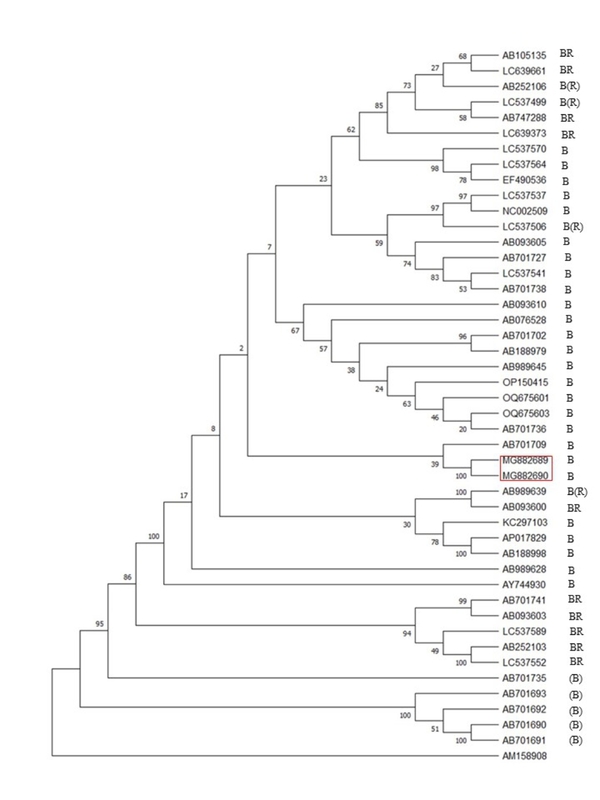RAPID COMMUNICATION
Turnip mosaic virus in rhubarb grown on farms in Poland
1
Plant Protection, The National Institute of Horticultural Research, Skierniewice, Poland
A - Research concept and design; B - Collection and/or assembly of data; C - Data analysis and interpretation; D - Writing the article; E - Critical revision of the article; F - Final approval of article
Submission date: 2024-11-13
Acceptance date: 2024-12-16
Online publication date: 2025-07-08
Corresponding author
Beata Komorowska
Plant Protection, The National Institute of Horticultural Research, Skierniewice, Poland
Plant Protection, The National Institute of Horticultural Research, Skierniewice, Poland
Journal of Plant Protection Research 2025;65(2):280-285
HIGHLIGHTS
- TuMV has been detected in rhubarb grown on Polish farms
- The Polish TuMV isolates belong to type B
- found
- The Polish TuMV isolates group with the virus isolate from rhubarb found in the UK
KEYWORDS
TOPICS
ABSTRACT
The aim of this study was the detection and molecular characterization of newly identified
turnip mosaic virus (TuMV) isolates infecting rhubarb in Poland. The presence of
the virus in rhubarb was confirmed by ELISA and RT-PCR techniques. The specificity
of the obtained products was verified by Sanger sequencing. Two sequences (1,077 nt)
of the TuMV coat protein gene and the 3’-terminal non-coding region were uploaded to
the Genbank database (access no. MG882689 and MG882690). The phylogenetic analysis
was performed based on the coat protein gene sequences of two new Polish isolates
from rhubarb and 43 other TuMV sequences retrieved from the Genbank. The isolates
studied were grouped with an isolate from rhubarb (AB701709) found in the UK (98%
nucleotide identity). It is the first phylogenetic analysis of TuMV isolates infecting rhubarb
in Poland.
FUNDING
The research was carried out under the statutory
theme: determination of the threat to vegetable and
ornamental crops by selected pathogens, their identification,
and determination of the need for and timing
of their control (ZF/1/2023 – 2.1.23).
RESPONSIBLE EDITOR
Beata Hasiów-Jaroszewska
CONFLICT OF INTEREST
The authors have declared that no conflict of interests exist.
REFERENCES (19)
1.
Boom R., Sol C.J., Salimans M.M., Jansen C.L., Wertheim-van Dillen P.M., van der Noordaa J. 1990. Rapid and simple method for purification of nucleic acids. Journal of Clinical Microbiology 28: 495–503. DOI: 10.1128/jcm.28.3.495-503.1990.
2.
Chupp C., Sherf A.F. 1960. Vegetable Diseases and Their Control. The Ronald Press Company. New York, p. 693.
3.
Crowther J.R. 1995. Methods in molecular biology. p. 415-420. In: “ELISA: Theory and Practice” (Crowther J.R., ed.). Humana Press, Totowa, USA.
4.
Gibbs A.J., Ohshima K. 2010. Potyviruses in the digital age. Annual Review of Phytopathology 48: 205–223. DOI: 10.1146/annurev-phyto-073009-114404.
5.
Hamlyn B.M.G. 1953. Quantitative studies on the transmission of cabbage black ringspot virus by Myzus persicae (Sulz.). Annals of Applied Biology 40: 393–402. DOI: 10.1111/j.1744-7348.1953.tb01091.x.
6.
Komorowska B., Ptaszek M., Jarecka-Boncela A., Hasiów-Jaroszewska B. 2018. First report of Arabis mosaic virus in rhubarb in Poland. Plant Disease 102: 1863. DOI:10.1094/PDIS-02-18-0324-PDN.
7.
Ohshima K., Yamaguchi Y., Hirota R., Hamamoto T, Tomimura K., Tan Z, Sano T, Azuhata F, Walsh J.A., Fletcher J., Chen J., Gera A., Gibbs A. 2002. The molecular evolution of Turnip mosaic virus; evidence of host adaptation, genetic recombination and geographical spread. Journal of General Virology 83: 1511–1521. DOI: 10.1099/0022-1317-83-6-1511.
8.
Parmar N., Thakur A.K., Kumar P., Thakur P.D., Bhardwaj S.V. 2017. Molecular characterization of Turnip mosaic potyvirus (TuMV)-infecting radish (Raphanus sativus L.) crop in India. 3 Biotech 7: 382. DOI: 10.1007/s13205-017-1016-y.
9.
Riechmann J..L.., Laín S., García J.A. 1992. Highlights and prospects of potyvirus molecular biology. Journal of General Virology 73: 1–16. DOI: 10.1099/0022-1317-73-1-1.
10.
Robertson N.L., Lanson D.C. 2005. Report of Turnip mosaic virus in rhubarb in Alaska. Plant Disease 89: 430. DOI10.1094/PD-89-0430B.
11.
Simmonds N.M. (ed.). 1976. Evolution of Crop Plants. London: Longman, UK, 339 pp.
12.
Stace-Smith R., Jacoli G.G. 1967. A virus disease of rhubarb in British Columbia. Canadian Journal of Botany 45: 1059. DOI: 10.1139/b67-111.
13.
Tamura K., Stecher G., Kumar S. 2021. MEGA11: Molecular Evolutionary Genetics Analysis Version 11. Molecular Biology and Evolution 38: 3022–3027. DOI:10.1093/molbev/msab120.
14.
Thomas J. 2011. Virus identification and development of long - term management strategies for the rhubarb industry. p. 92–93. In: Final report Hal Project VG05053. Horticulture Australia: Sydney, NSW, Australia.
15.
Thompson J.D., Higgins D.G., Gibson T.J. 1994. CLUSTAL W: improving the sensitivity of progressive multiple sequence alignment through sequence weighting, position-specific gap penalties and weight matrix choice. Nucleic Acids Research 22: 4673–4680. DOI: 10.1093/nar/22.22.4673.
16.
Tomimura K., Špak J., Katis N., Jenner C.E., Walsh J.A., Gibbs A.J., Ohshima K. 2004. Comparisons of the genetic structure of populations of Turnip mosaic virus in West and East Eurasia. Virology 330: 408–423. DOI: 10.1016/j.virol.2004.09.040.
17.
Tomlinson J.A., Walkey D.G.A. 1967. The isolation and identification of rhubarb viruses occurring in Britain. Annals of Applied Biology 59: 415-427. DOI: 10.1111/j.1744-7348.1967.tb04458.x.
18.
Tomlinson J.A. 1987 Epidemiology and control of virus diseases of vegetables. Annals of Applied Biology 110: 661–681. DOI: 10.1111/j.1744-7348.1987.tb04187.x.
19.
Walkey D.G.A., Cooper V.C. 1972. Comparative studies on the growth of healthy and virus-infected rhubab. Journal of Horticultural Sciences 47: 37–41. DOI: 10.1080/00221589.1972.11514437.
Share
RELATED ARTICLE
We process personal data collected when visiting the website. The function of obtaining information about users and their behavior is carried out by voluntarily entered information in forms and saving cookies in end devices. Data, including cookies, are used to provide services, improve the user experience and to analyze the traffic in accordance with the Privacy policy. Data are also collected and processed by Google Analytics tool (more).
You can change cookies settings in your browser. Restricted use of cookies in the browser configuration may affect some functionalities of the website.
You can change cookies settings in your browser. Restricted use of cookies in the browser configuration may affect some functionalities of the website.




